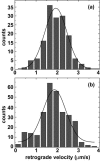The Herpesvirus capsid surface protein, VP26, and the majority of the tegument proteins are dispensable for capsid transport toward the nucleus
- PMID: 16699029
- PMCID: PMC1472179
- DOI: 10.1128/JVI.00026-06
The Herpesvirus capsid surface protein, VP26, and the majority of the tegument proteins are dispensable for capsid transport toward the nucleus
Abstract
Upon entering a cell, alphaherpesvirus capsids are transported toward the minus ends of microtubules and ultimately deposit virus DNA within the host nucleus. The virus proteins that mediate this centripetal transport are unknown but are expected to be either viral tegument proteins, which are a group of capsid-associated proteins, or a surface component of the capsid itself. Starting with derivatives of pseudorabies virus that encode a fluorescent protein fused to a structural component of the virus, we have made a collection of 12 mutant viruses that lack either the VP26 capsid protein or an individual tegument protein. Using live-cell fluorescence microscopy, we tracked individual virus particles in axons following infection of primary sensory neurons. Quantitative analysis of the VP26-null virus indicates that this protein plays no observable role in capsid transport. Furthermore, viruses lacking tegument proteins that are nonessential for virus propagation in cell culture were also competent for axonal transport. These results indicate that a protein essential for viral propagation mediates transport of the capsid to the nucleus.
Figures



References
-
- Desai, P., N. A. DeLuca, and S. Person. 1998. Herpes simplex virus type 1 VP26 is not essential for replication in cell culture but influences production of infectious virus in the nervous system of infected mice. Virology 247:115-124. - PubMed
Publication types
MeSH terms
Substances
Grants and funding
LinkOut - more resources
Full Text Sources
Other Literature Sources

